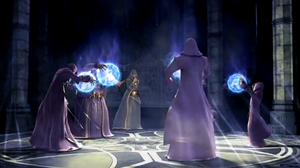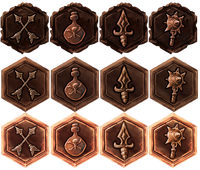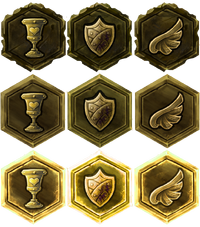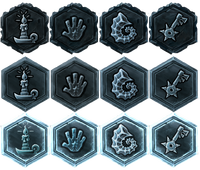League of Legends (LoL) is a real-time strategy action video game developed and published by Riot Games for Microsoft Windows, inspired by the popular Defense of the Ancients map for Warcraft III.
General
Players are formed into 2 even teams of Champions, 3v3 or 5v5. There are 100 different champions from which to choose. Each player begins at opposing sides of a map in an area called the Spawning Pool, near what is called a Nexus. A match is won when either team's nexus is destroyed. To destroy a Nexus, each team must work through a series of Turrets placed along a path to each base referred to as a Lane. Along the way, each player gains levels from killing the opposing team's champions and Minions and defeating neutral monsters.
Game modes and matchmaking
League of Legends is a session-based game. Matchmaking occurs based on the average Elo ratings of each individual players, with slight proprietary adjustments.
The game can currently be played in five different modes: Tutorial, Custom, Co-Op vs. AI, Normal and Ranked.
Tutorial mode teaches you the basics of the game.
Custom mode allows players to manually create custom game sessions that other players can find on a game list and join.
Co-op vs. AI mode is a mode where players are matched either alone or as part of a group against a team of bots.
Normal mode matches players according to their hidden elo with other players in a blind pick format
Ranked mode originally became available to players of level 20 and higher, but was later changed to only be available to players of level 30 Ranked uses Draft Mode where each team can ban up to 3 champions from the game, and the two teams cannot play the same champion. In addition, opponent Champions picks are visible before the loading of the actual game. Second, an exclusive, visible rating is calculated based on the player's performance in Ranked games. The player is placed on the ladder according to their rating, and top teams on the ladder have a chance to compete in the "Global Finals" at the end of the season.
Fields of Justice
Maps in League of Legends are called Fields of Justice. There are currently four Fields of Justice that the players can choose from :

The Proving Grounds

Summoner's Rift

The Crystal Scar

Twisted Treeline
A match puts two teams with a fixed number of players against each other. Each team has its base, which contains the re-spawn point, item shop and nexus. The two bases are connected by lanes. Periodically, waves of minions spawn from the nexus, AI-controlled troops that walk down the lanes, engaging any enemies they encounter. The lanes are lined with turrets that engage enemies within range. Once a turret is destroyed, it cannot be rebuilt. Each lane has an inhibitor on both ends. If a team destroys the enemy inhibitor, more powerful "super minions" will spawn for that side. Unlike turrets, inhibitors respawn after a fixed amount of time.
Besides the lanes, the maps also contain "jungle" areas, which contain neutral monsters to be killed for bonus gold and experience. Some powerful neutral monsters grant the killer a temporary buff that will help them in battle. Another special terrain feature is the brush. Brush blocks the line of sight of units, allowing champions to hide and set up an ambush.
The goal of each team is to destroy the enemy Nexus. The first team to achieve this is the victor. Victory is also attained if the opponent surrenders, using a voting system where 4 out of 5 must agree, but only after enough time has passed.
Persistence and meta-game
Summoner
Summoners gain "experience points" and "Influence Points" (in-game currency) for each battle they participate in. They level up by getting enough experience.
The Summoner can also choose two summoner spells. These spells significantly impact gameplay, and have a high cooldown while costing no mana. All spells can be improved by masteries, which are developed in a skill tree.
Masteries
Runes
An empty Rune page
Marks (Offensive)
Seals (Defensive)
Glyphs (Magic)
Quintessences (Utility)
Runes must be unlocked in the Store and it is possible to have more than one copy of a rune. Summoners must arrange their runes in the Runebook to benefit from them. The Runebook has limited number of slots for each rune type, but more rune pages can be purchased from either Influence Points or Riot Points. Combining two equal-tier runes produces a random rune of the same tier, while combining 5 equal-tier runes produces a higher-tier rune.
Store
The League of Legends Store allows Summoners to purchase additional options through Riot Points (RP) and Influence Points (IP).Riot Points must be bought using real money, while Influence Points are earned by playing the game.









No comments:
Post a Comment